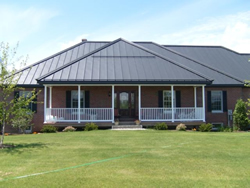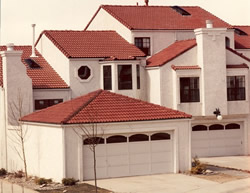
Figure 3 - Standing seam metal roof
The vast majority of metal roofs are known as standing seam roofs, as shown in Figure 3, which describes the method by which each panel is attached to an adjacent panel. The standing seam creates a series of vertical lines on the roof. Metal roofing material is also available to simulate the aesthetics of other materials such as shingles, wood shakes, metal and clay times.
Metal roofs have many advantages:
- Long life
- Fire resistant
- Maintenance-free
- Energy efficient
- Environmentally friendly
The installation of a metal roof is usually left to the professionals to ensure a weather tight installation.

Figure 4 - Concrete tile roof
Additional information on metal roofs.
Concrete Tile
Concrete tile, as shown in Figure 4, is definitely not my first choice for a roofing material. The primary reason is that it is one of the most difficult roofing materials to install properly, especially in roof valleys, vent pipes, flues and chimneys
Although concrete tile has a life of 50 years, the sheathing and underlayment will usually need replacement long before the concrete tile.
Concrete tile is a single layer roofing system. Roofing systems such as asphalt and cedar shakes overlap each other. If you were to drill a hole through either of these roofing systems you would drill through multiple layers of roofing material. With a concrete tile roofing system you would drill through the sheathing after drilling through one concrete tile. This means that water can easily penetrate the concrete tiles where they join together at their ends and sides.
One of the biggest advantages to concrete tile is that it is highly resistant to damage from hail and allows snow falls to slide off with relative ease.
Although the technology used to make concrete tiles has come a long way in the past decade, I believe it has a way to go before it is a valued material for roofing.
